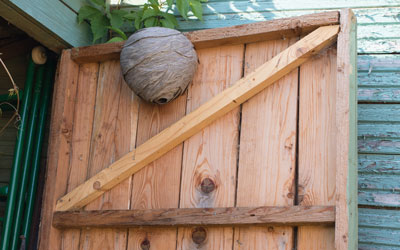 Wasps are one of the most common summertime insects here in Virginia. Out in nature, wasps are a beneficial addition to our environment. However, they can become somewhat dangerous when their nests are built on homes or buildings. Certain wasp species become very aggressive, and will chase people. Most of them can sting repeatedly, which is very dangerous for anyone who is allergic to stings. It’s important to learn how to identify different types of wasp nests that you may encounter this summer or fall. If you notice any of the below nests, exercise caution and try to avoid the nest at all costs. Keep reading to learn about what to look out for from the experts at Loyal Termite & Pest Control.
Wasps are one of the most common summertime insects here in Virginia. Out in nature, wasps are a beneficial addition to our environment. However, they can become somewhat dangerous when their nests are built on homes or buildings. Certain wasp species become very aggressive, and will chase people. Most of them can sting repeatedly, which is very dangerous for anyone who is allergic to stings. It’s important to learn how to identify different types of wasp nests that you may encounter this summer or fall. If you notice any of the below nests, exercise caution and try to avoid the nest at all costs. Keep reading to learn about what to look out for from the experts at Loyal Termite & Pest Control.
4 Wasps and Their Nests
Different types of wasps build different nests! In order to identify a wasp, it’s sometimes easiest to identify them through their nest. Here are the main characteristics of each:
- Yellowjackets. These nests are made of a papery material and have a single opening. The inside of a yellowjacket nest can have up to 100 tiers of cells. Yellowjackets can also build underground nests that can be enormous in size.
- Paper wasps. Their nests famously look like upside-down umbrellas. These nests are often open, and can get quite large in size. They are typically supported by a single stalk and consist of a paper-like material.
- Mud daubers. Female wasps build their nests out of mud. The nests are small and tubular in size, often looking like organ pipes. They are typically found in cracks or crevices.
- Bald-faced hornets. These nests are almost always at least three feet off the ground. They are made of chewed wood fibers mixed with saliva. They often grow to be the size of a football or basketball.
Top Wasp Nest Locations
Many people assume that wasp nests are primarily found in trees. However, certain wasps prefer other spots to build their nests. For example, paper wasp nests can be located under and within the eaves of structures, in attics and wall voids, and in other enclosed areas. Yellowjackets favor areas near the ground, in hollow trees, under porches, and a number of other areas. The bald-faced hornet builds its nest oftentimes in trees, bushes, or wooded areas. Mud daubers, as solitary wasps, built their nests for eggs in sheltered areas. They are often in areas that provide protection from any rain. In sum, a wasp nest can be built many different areas, making it important to know what to look out for.
Safe Nest Removal
Nests are dangerous, bottom line. Yellowjackets and bald-faced hornets in particular can be very aggressive and sting repeatedly if they feel their nest is at threat. DIY nest removal is never recommended and can endanger those around you. If you need a wap nest removed, always contact your local stinging insect control team at Loyal for help.
What Do Different Wasp Nests Look Like in Virginia?
Serving the Henrico and Richmond VA area since 1960

